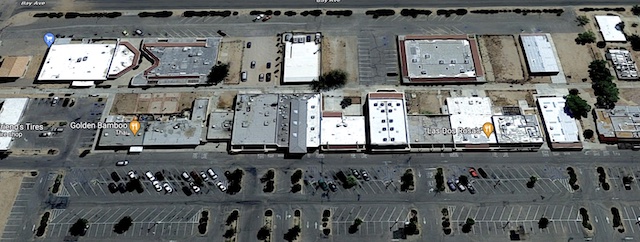Last week, I complained that, under the Census Bureau’s new definition of “urban,” Bandon, Oregon is rural. It turns out that it squeaked into the list of urban areas by virtue of having 2,012 housing units. (My count of housing units was based on the Census Bureau’s 2018 estimates.)
This large shopping center in California City, California isn’t enough for the Census Bureau to classify it as “urban.”
However, 1,143 areas that had been classified as urban in 2010 were counted as rural in 2020. To be urban, an area had to have either 5,000 people or 2,000 housing units and an urban core that had at least 1,275 housing units per square mile.
Because of this core requirement, nearly 100 areas that had been urban in 2010 were counted as rural in 2020 despite having more than 5,000 people. Seven had more than 10,000 residents in 2010: Sierra View-Indian Mountain Lake, PA (2010 population: 27,347); Hawaiian Paradise Park, HI (20,503); Kalaheo, HI (14,840); Chaparral, NM (12,328); Lake Los Angeles, CA (11,808); California City, CA (10,908); and Shady Side-Deale, MD (10,783).
Some of these, such as Hawaiian Paradise Park, are basically large lot subdivisions with no local businesses. But others, such as California City, are incorporated cities with supermarkets, schools, fire departments, and police, and other urban attributes. Others, such as Chaparral, NM, are really suburbs of other cities, in this case El Paso, and should have been counted in the urban areas for those cities.
Using the new definition of urban, just under 105,500 square miles of the United States is classified as urban, which is just under 3.0 percent. The 2010 land areas of the 1,143 communities that have been reclassified as rural total to 3,117 square miles, or 0.09 percent of the nation. If this is added to the other urban land, the total is less than 3.1 percent.
On the whole, then, the reclassification doesn’t make much difference to anyone’s worries about urban sprawl. But I still question why the Census Bureau needed to redefine these areas as rural.
You can read demographer Wendell Cox’s analysis of the new urban area data on New Geography. He notes that the Census Bureau counted 80.0 percent of the 2020 population as urban, which was down from 80.7 percent in 2010. This decline was largely due to the exclusion of 1,143 communities from urban land, as their 2010 population was about 1.3 percent of the nation’s total.








